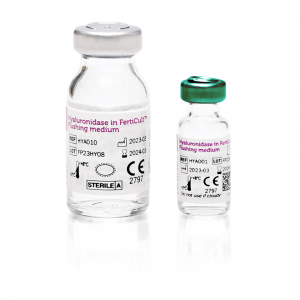Hyaluronidase in FertiCultTM Flushing medium
Intended use
Hyaluronidase in FertiCult™ Flushing medium is used in the oocyte denudation process in preparation of intracytoplasmic sperm injection (ICSI) or other Assisted Reproductive Technologies. Hyaluronidase digests the hyaluronic acid between the cumulus cells, which makes it easier to remove the cumulus mechanically.
Hyaluronidase in FertiCult™ Flushing medium is ready-to-use.
Composition
Hyaluronidase in FertiCult™ Flushing medium is a HEPES-buffered medium which also contains bicarbonate, physiologic salts, glucose, lactate, pyruvate, human serum albumin (4.0g/l, medicinal substance derived from human blood plasma) and 80 IU/ml hyaluronidase from bovine origin.
Further information on the composition of the medium can be found in the material safety data sheet.
Regulatory
- Europe: CE-marked (MDR, Notified Body number 2797)
- Brazil: Registered
- Canada: Health Canada License
- Other regions: Information available upon request
Product order codes
HYA001 : 5x 1ml Hyaluronidase in FertiCult™ Flushing medium
HYA010 : 1x 10ml Hyaluronidase in FertiCult™ Flushing medium

Hyaluronidase in FertiCult Flushing medium is a ready-to-use cell culture medium for oocyte denudation

